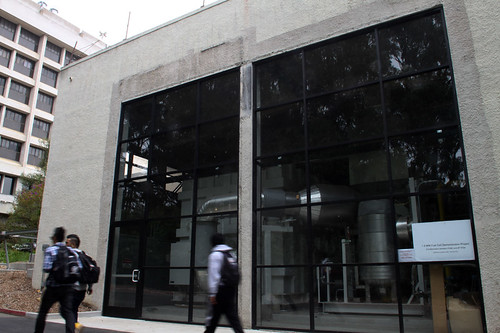In one of the back alleys near Hensill Hall, a newly unveiled winding steel contraption lurks behind a weather-proof window pane.

The building, previously an old boiler room, now houses a fuel cell complex, a set of generators that use common elements such as hydrogen and oxygen in the form of natural gas to make electricity through a chemical reaction, said Wendy Bloom, campus planner of SF State Capital Planning, Design, and Construction. The project, coordinated by CPDC and Pacific Gas and Electric, was constructed as an alternative source of energy production.
The electricity generated by the complex is transferred to a PG&E powergrid on 19th and Holloway avenues while the excess heat produced as a byproduct of the electrochemical reaction is used to heat campus buildings, Bloom said.
According to Kwok-Siong Teh, SF State assistant professor of mechanical engineering, a fuel cell is an alternative form of energy that has potential to be cost-effective and reduce pollution emissions.
“Fuel cell is one of the technologies that are explored extensively,” Teh said. “If we can take a cheap resource such as hydrogen, we can store and transport them and use them like fossil fuel.”
While PG&E provided an $10.3 million for construction, SF State provided $500,000 to use the byproducts to heat the campus loop, an investment which will pay itself off in 2 years through reduced energy costs, according to Bloom.
While it is fully functional in energy production, the engineering department plans to use it as a source of student study as well.
“I did meet with (CPDC) once to see if we could set up some sort of educational component,” said Ed Cheng, SF State associate professor of mechanical engineering. “It was not designed to be instructional, it was designed for energy.”
But students must wait for a few more adjustments to the cell generator before it is ready for academic use.
“It’s working, but it would be too hot to step inside,” said Simon Lam, Associate Vice President of CPDC.
Despite the immense size of the generator, some students haven’t noticed it because it was completed this summer.
“I didn’t even know about it,” said Giancarlo Lara, a SF State mechanical engineering senior, who expressed an interest in viewing the complex. “It’s something new, something different.”
Although the fuel cell generators emit less pollution and can operate on inexpensive resources, the method might not be as cost-efficient as one would assume.
“It’s not always about how much energy goes in and out,” Teh said.
Teh acknowledged that hydrogen might not be a cost-effective fuel source because it is becoming increasingly costly; however, the price of using water to make electricity is currently still cheaper than using other forms of fuel.



